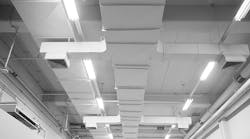Variable refrigerant flow (VRF) is quickly becoming a top HVAC choice in U.S. facilities since its first stateside implementation in 2002. What started as an idealized and imported “next-gen” solution for HVAC in North America is now finding footing.
“It really started as a niche product where we looked at buildings that didn’t have space or a lot of ductwork, but now we’re seeing that this can be applied to basically any building,” says Scott Gilchrist, regional sales manager, Pacific Region of LG Electronics. “We’re really seeing a lot more applications for this technology.”
With its improved flexibility making it viable for most types, sizes and locations of facilities, VRF systems have outpaced the growth of other types of HVAC technologies over the last decade, making up roughly 6-8 percent of all HVAC systems in the U.S. Its use in commercial facilities is expected to continue growing, fulfilling its status as the HVAC system of the future, says Kevin Miskewicz, director of Commercial Marketing at Mitsubishi Electric Cooling & Heating.
What makes VRF ideal for this wide range of buildings? And is it the right choice for a retrofit of your facility?
The Hallmarks of VRF
As facilities continue to adopt VRF systems, the perceived limitations of their application seemingly evaporate. While they do have some drawbacks, the benefits these systems provide have made them an adaptable and efficient solution that is driving FMs to replace other HVAC systems with VRF.
“The change is coming from the owners who gravitate to higher efficiency, easier zoning, better flexibility, attractive aesthetics and space saving that VRF systems offer,” says Vic Perez, sales director of Samsung HVAC’s Eastern Region. “VRF offers building owners greater flexibility, easier building integration, simpler localized control and less costly maintenance due to fewer components to service.”
The first main benefit of a VRF system is energy efficiency because air no longer needs to move through ductwork. Instead the system simply moves conditioned refrigerant to the locations where you need it. While the energy efficiency is going to depend in large part on how you implement VRF in different spaces, the David Whitney Building in Detroit, for example, expects to save 20-30 percent in energy costs with its recent HVAC renovation.
BUILDINGS Checklist
Facility Condition Assessment: Equipment Inventory Form
Do you currently know how your facility’s equipment is operating? If you conduct a facility condition assessment each year, you’d know. Get organized and help save money and time with this equipment inventory sheet. Get yours here >>
One area where VRF has developed significantly over the last several years is in its controls. In addition to providing better control for individual spaces, VRF technology has improved to promote better integration into building automation systems for more precise oversight of heating and cooling.
“When VRF systems first came out, the control of the system was proprietary. So for the first couple generations of systems it was hard to communicate with the building automation system,” says Vic Amoroso, principal at A&J Associates, an engineering firm in North Liberty, IA. “The two control systems weren’t compatible, but they have improved that so it’s not as hard as it used to be to integrate VRF controls with building automation systems.”
Ditching the Ductwork
When integrated properly in a building, VRF can give FMs greater control and efficiency for HVAC. However, the freedom systems like these can afford for organizations looking to retrofit buildings is one of the technology’s biggest draws. The small refrigerant piping is far less invasive than ductwork, allowing for a simplified installation process that significantly reduces construction.
Its small footprint and options for customization often make it an ideal system for existing buildings. The minimized (or elimination of) ductwork doesn’t just make it easier to introduce into any type of space – it can also give FMs the ability to make larger changes that won’t cause major disruptions.
[On topic: 13 HVAC Money-Saving Products for 2019]
“Instead of having to make accommodations for 12- or 24-inch ductwork, you’re now only dealing with about an inch of refrigerant piping, which can have major impacts on a building,” explains Miskewicz. “You can raise ceiling heights or add usable space. You can be more flexible to satisfy the needs of your tenants.”
Even though the possible applications for VRF are ever expanding, there are some types of facilities where VRF will not work as well as in others. Especially small buildings are often not ideal for a prompt return on investment, while facilities with large open spaces like school gymnasiums might be challenging for VRF systems to handle fully.
Nevertheless, architects and engineers are finding new ways to apply VRF to these more difficult facilities, so if you are considering implementing it, be sure to consult with HVAC professionals to find the best method.
“The flexibility of VRF systems makes them an ideal candidate for most applications, with the exception of those that require very high rates of filtration like operating rooms. The frequency and volume of required air changes exceeds the capability of VRF systems,” says Miskewicz. “If you take those kinds of applications off the table, every other building design and application is potentially a fit for a VRF system.”
Air-Cooled vs. Water-Cooled
The flexibility of VRF also comes through its main modes of cooling, which will dictate the type of equipment you need and how you need to configure it. Each type of system – air-cooled and water-cooled – comes with its own advantages and disadvantages.
The main requirement of an air-cooled system is that it has some access to outside air. This often manifests in the installation of condensers on the rooftop, in the basement or on the side of a building, depending on the height and size of the structure.
“Air-cooled systems can be placed on roofs, mounted indoors with ducts to the outside and used on grade level installations,” says Perez. “VRF systems are faring very well against chilled water systems in the marketplace due to better part load efficiencies and simplified equipment requirements, such as the elimination of cooling towers, pumps, boilers, etc.”
[Related: Are Energy-Saving VRF Systems Worth the Money?]
An air-cooled system might be a design challenge for some buildings like high-rises, for example, because they often require creative placement for condensers not located at the top or bottom of a building. For those that want to avoid that kind of issue, water-cooled systems might be the right choice.
“Water-cooled systems can offer a more flexible installation, compact design and can be utilized for geothermal heating and cooling,” explains Perez. “In cold climates, the water-cooled unit is not affected by outdoor ambient conditions.”
Despite the flexibility they provide, water-cooled systems that use cooling towers require special attention. Legionella is always a risk with a system like this, and FMs looking to avoid the headaches associated with a possible Legionnaires’ disease outbreak might not go with water-cooled systems.
The Geothermal Option
While they both have their own benefits, traditional air-cooled and water-cooled VRF systems might not be the best choice for your facility, especially if you have enough land to work with. By integrating VRF with geothermal wells, you can eliminate the climate concerns of an air-cooled system and the cooling tower issues associated with water-cooled systems.
In the Muscatine County Courthouse in Muscatine, IA, integrating VRF with geothermal helps a historical building in a harsh winter climate avoid some of the issues associated with an air-cooled VRF system. If you have an air-cooled system in climates similar to Iowa, you might run into problems without a supplemental heat system.
Air-cooled systems without supplemental heat in the winter will often lose efficiency because less heat is recovered due to the time needed to defrost the coils, explains Amoroso: “If you have enough real estate to put in wells, you can run that VRF off the geothermal system. Then you don’t have to worry about supplemental heat.”
BUILDINGS Podcast
How HVAC Industry Recruits Next Generation
BUILDINGS’ Sarah Kloepple speaks with Susan Kaufman from Daikin Applied about their Next Generation Event they hosted at AHR Expo 2019 in Atlanta.
The event, created exclusively for engineering and technical trade students during the show, helps to foster interest in HVAC professions. Listen here >>
The courthouse, which was built in 1907, had previously made use of dated HVAC equipment that leaked water, detracted from the historical aesthetics of the building and were loud. With the geothermal well field that had been constructed in 2002, engineers decided they could improve HVAC by implementing VRF rather than replacing boilers and chillers completely.
Projects that use geothermal have avoided some of the problems of traditional water-cooled and air-cooled systems, but they are only available to organizations with more enough real estate space to install the well field.
Ultimately, fewer buildings in the U.S. are not a good fit for VRF. It requires the right combination of equipment and installation strategies, but the flexibility afforded in the wide-ranging implementations of VRF might be the answer for your facility.
Two handpicked articles to read next:
Justin Feit was an associate aditor of BUILDINGS. Article was originally posted in Jan. 2018.



